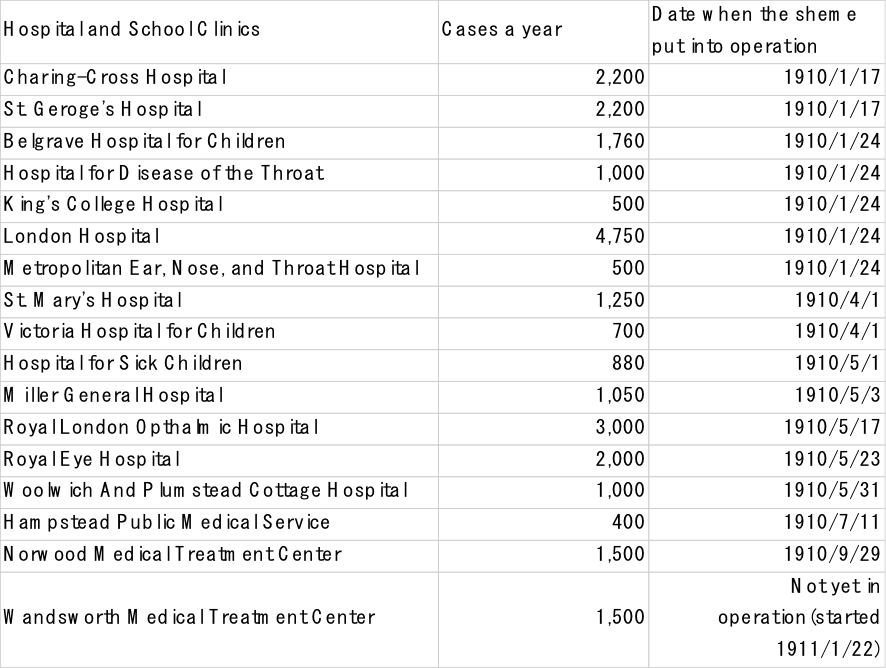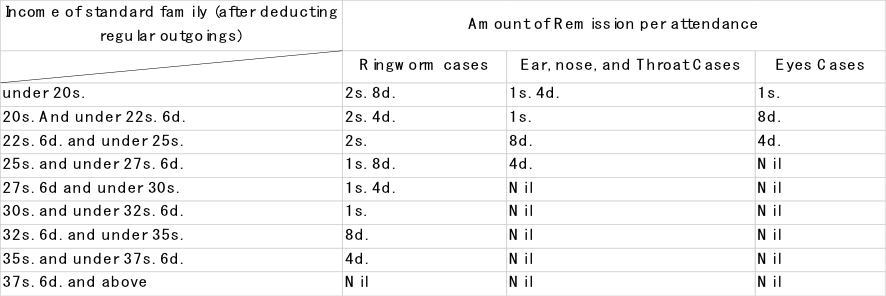The Development of School Medical Service in the early 20th Century in England and Wales;Focus on the Work of London School Clinics
Name: Masuda, Keisuke
1. Purpose of study
I’d like to talk about how the parents of children who were provided with
medical treatment could obtain the treatment under the school medical service
in the early 20th century in London.
2-1. School Medical Service
What is the School Medical Service in the early 20th century in London?
This service was initiated after passing of 1907 Education Act (Administrative
Provisions). This Act gave Local Education Authorities the duty to make
arrangements for the medical inspection of children attending Public Elementary
Schools, and the power to make arrangements for medical treatment. So,
the target is school children attending public elementary school. This
service is called ‘School Medical Service’. School Medical Service means
to provide for medical inspection of children educated in public elementary
schools and for medical treatment of them through the hospitals and the
school clinics.
Recent Researchers, such as Hirst(1981), Harris(1984, 1995, 2003), and
Welshman(1990) have discussed the origins or the organization of school
medical service. But, they don’t clarify how the parents were provided
with medical treatment, and especially they don’t pay attention to the
medical institutions such as school clinics at all.
2-2. Method
My purpose is to examine how the parents obtained the medical treatment
through the medical inspection in the schools, and how many parents were
provided for medical treatment through the school clinics. To discuss these
points, I examine the work of medical inspection in the routine inspection
and simpler plan, and of school clinics-Norwood and Wandsworth medical
treatment centers- by the Report, Minutes, Letters, and Correspondence
of each center and Minutes of the Children’s Care (Central) Sub-Committee.
3-1. Medical inspection under the 1907 Education Act
What is the medical inspection? The aim of this service was to discover
the unhealthy or sick school children and to treat them. In 1907, Board
of Education stated that ‘the aim of the school medical service was the
physical, mental, and moral improvement of coming generations’ . This service
made the arrangements for the medical inspection for the school entrants
and leavers. The former was about 7 or 10 years old. They were inspected
by school doctor appointed by the council. And, The School Nurse also be
employed, and she was mainly assistant for him in the work of medical inspection.
3-2. Medical Inspection in London County Council
The council adopted two systems of medical inspection. At first, the routine
system was adopted. It was recommended by the Memorandum of medical inspection
which it issued Board of Education on the November 22nd 1907 . And, after
April 1909, the council started new system of simpler plan. This was the
original system adopted by Dr. James Kerr, Medical Officer (Education)
in the London County Council. The school children in London were provided
with medical inspection by these systems.
3-3. Routine Inspection
The council decided to start the routine inspection by the schedule of
the Board of Education. The School doctor appointed by the council inspected
the children in the following procedure :
1. Check the list of all school children’s name before the doctor visited.
2. Inspect the school children selected by a teacher.
3. Note any case presenting defects of hearing, brain, speech, limbs or
nutrition.
4. Go over the school and note any defects in regard to the general arrangements
of building, general condition of school, the hygiene of school work, and
any other matters which affected the health of the teacher and children
and the psysiological development of the latter.
5. Discover any child who medically examined with a view of admission to
special schools.
6. Note in the medical register any school conditions which are detrimental
to the health and well-being of the teachers and children, and also enter
the names of any children where conditions existed such as discharging
ears, very defective vision, etc…, where the managers could assist in obtaining
relief.
3-4. Simpler Plan
After April 1909, the Council adopted simpler plan. They adopted not only
the school doctor but also school nurse in the simpler plan. Under the
simpler plan, the school children were inspected in the following procedure
:
1. Before the school doctor visit schools, the teachers are forwarded the
medical record register, and they note on these cards the name, address,
date of birth, etc.
2. The teachers send a form to the parents of the children to be examined,
informing them of the date of the examination and inviting them to be present.
3. The school nurse arrives at the school before the doctor and make the
necessary preparation for the examination.
4. The school nurse are required, under the doctor’s supervision, to examine
the children, to obtain from parents particulars in regard to the family
history and details of previous illness, and to enter, from the doctor’s
dictation, the results of the examination on the medical record card.
5. At the examination a copy of the treatment card is handed to the parent
of each child where the doctor is of opinion that medical treatment would
be beneficial and the name of the child with the nature of the defect is
entered in the medical register by the school nurse.
6. Where the parent was not present, the nurse delivered the treatment
card at the home and impress upon the parent the necessity of obtaining
the treatment prescribed.
7. The doctor goes over the school and note the general arrangement of
the building, general condition of the children, hygiene of school work,
as set out routine inspection.
3-5. Routine Inspection and Simpler Plan
Children’s Care Committee reported the results of medical inspection in
the routine inspection and simpler plan. The Table 1 shows the results
of the routine inspection and the simpler plan. The total number of children
examined was about 5,000 in the routine inspection, and 6,000 in the simpler
plan. Especially, under these systems, percentage of parents attending
school was about 70%. This means most of the parents attended school .
Table 1: The Results of the Routine Inspection and the Simpler Plan

3-6. Parents Committing to Medical Inspection
As the table 1 shows, about 70% parents were attending to schools to figure
out the condition of their children through the medical inspection at the
schools. Parents could obtain the information about the condition of their
children and they were required to take their children to the medical institutions.
Especially, in the case of the simpler plan, the school nurse had an essential
role to create the connection with the parents, school doctor and teachers
in order to provide school children for medical inspection and treatment
in London.
4-1. The Way of the Medical Treatment
If the school doctor diagnosed the school children as being any illness
by the medical inspection, parents were requested to take them to the medical
institutions such as the hospitals (or the private medical practitioners)
and school clinics. The hospital was a traditional provision of medical
treatment for children. Children were dealt with in the outpatient department.
On the other hand, the school clinics was established by local general
practitioners to provide school children who seemed to be disease for medical
treatment. Those who used school clinics were only children attending public
elementary school in the near them.
4-2. The Hospitals and the School Clinics in London
How many the hospitals and the school clinics were established in London?
Table 2 is the list of the medical institutions contracted with the Council
from January to September 1910. There were 17 institutions in the London
during this period. 3 School clinics were established until January 1911,
which were Hampstead Public Medical Service, Norwood Medical Treatment
Center, and Wandsworth Medical Treatment Center .
Table 2 Medical Institutions contracted with the London County Council
from January to September 1910

4-3. The Cost of the Medical Treatment
Basically, medical treatment in the School Medical Service covered three
departments such as the eyes department, ears nose, and throat department,
and skin department until 1911. In accordance with the requirements of
the Local Education Authorities (Medical Treatment) Act, 1909, the council
had to fix the amounts to be charged to parents in respect of the medical
treatment of their children. Then, the amounts to be charged to parents
were different in three departments. For example, in the case of the ringworm
cases, the council charged the parents 3s. for each attendance provided
that the total charge does not exceed 15s. for each child. But, when the
circumstances of the parents render them incapable of paying the fixed
amounts, remission was allowed by the Children’s Care committees. The Table
3 shows the rate of remission per attendance. Parents who were a poverty
situation could take their children to the medical institutions at low
cost .
Table 3 The Rate of Remission per Attendance

4-4. Establishment of School Clinics in London
In London, the school clinics were established by the council during 1910.
After 1910, the council contracted with various committee of general practitioners,
which frequently administered the school clinics in their districts. So,
This Paper focuses on the work of the two clinics-Norwood and Wandsworth
medical treatment centers, and we discuss how many children were provided
for medical treatment each center.
4-5. How Many School Children Attended Each Center?
Table 4 is the number of cases provided for in the agreement and the number
who attended in the Norwood and Wandsworth centers. most of school children
attended three departments, exclusive of skin department, compared the
number of cases provided for in the agreement. For example, In the eyes
and ears, nose and throat department of Norwood center, the number of cases
provided for in the agreement was 650. The number of the school children
who actually attended were 543. Especially, in the ears, nose, and throat
department of Wandsworth center, although number of cases provided for
in the agreement was 125, indeed, the center dealt with 186 .
Table 4: The Number of Cases Provided for in the Agreement and the Number
Who Attended in the Norwood and Wandsworth Centers

And, Table 5 is the number who attended until discharge and ceased attendance
before being discharged in the Norwood and Wandsworth centers. In the Norwood
center, the number who ceased attendance before being discharged was very
little; in fact, the number is 1 in the eyes department, and 6 in the ears,
nose and throat department. On the other hand, in the Wandsworth center,
any school children ceased attendance before being discharged. The number
was more than Norwood center .
Table 5: The Number Who Attended Until Discharge and Ceased Attendance
Before Being Discharged in the Norwood and Wandsworth Centers

4-6. Parents Attending to School Clinics
As the Table 4 showed, most of school children attended three departments,
exclusive of skin department, compared the number of cases provided for
in the agreement. Especially, in the ears, nose, and throat department
of Wandsworth center, although number of cases provided for in the agreement
was 125, indeed, the center dealt with 186. As the Table 5 showed, in the
Norwood center, the number who ceased attendance before being discharged
was very little, on the other hand, in the Wandsworth center, any school
children ceased attendance before being discharged. The Number was more
than Norwood center. Therefore, this result shows that a number of parents
were provided for medical treatment in each center, moreover, there were
some parents who refused or ceased to attend.
5. Conclusion
Under the School Medical Service in the early 20th century in London,
Parents, who were informed that their children were unhealthy or sick through
the medical inspection, would adopt the following choices:
1. taking their children to medical institutions to treat them.
2. taking their children to medical institutions to treat them, but they
ceased to attend owing to various reasons such as not being able to pay
the cost of the treatment.
3. refusing to treat their children
On the one hand, Parents were sought to care the condition of their children
through the medical treatment, on the other hand as the Table 5 showed,
some parents refused or ceased to attend.
The Children’s Care (Central) Sub-Committee reported in regard to results
of the Table 4 and 5 that the parents ceasing attendance before being discharged
in Wandsworth were in poverty situation, also evaluated that this problem
was because of the poverty parents . Thus, focusing on the relationship
with the child health and economic situations is a problem in regard to
the improvement of child health. For example, in contemporary debate, Adachi
education committee at Tokyo in Japan, reports that factors of improving
the condition of children are not only parent’s economic situation but
also whether the parents have the concern about the condition of children
.The problem occurred in the school clinics in London and Adachi education
committee report show that it is essential factor that parents have a concern
of the condition of children to improve the child health.
slide